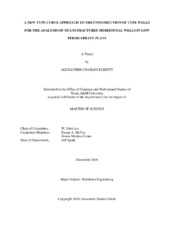| dc.description.abstract | The oil and gas industry has urgent need for accurate methods to forecast performance of future wells and of those without extensive production histories producing from unconventional plays. Reliable assessment of potential future wells allows producers to evaluate their drilling programs and enables them to arrive upon economically sound development strategies. Similarly, accurate forecasting of those wells already drilled but with short production histories is critical for portfolio management, as it enables evaluation of the existing portfolio’s current performance and additionally serves as a critical review of decision-making methodology. By constructing type wells at varying levels of uncertainty (P90, P50, and P10), producers will be able to approach these matters statistically and thus avoid the pitfalls associated with deterministic methods and the means by which they address uncertainty.
This thesis presents a newly-developed type curve that may be used to assess reservoir and completions properties and forecast future production from multi-fractured horizontal wells in unconventional, low permeability formations. Additionally, a methodology for the construction of statistical type wells by applying the aforementioned type curve analysis to a large set of wells from a given resource play is proposed. To construct the type wells, all individual wells from a data set are first analyzed individually and then scaled to a common set of reference parameters. Once scaled, wells are ranked by EUR, after which type wells are constructed for each chosen level of uncertainty using the production profile of wells of the corresponding percentile.
Results of this research suggest the new type curve is an effective means by which matrix permeability and fracture half-length may be determined and by which future production may be
forecast. The inclusion of early-time data may distort these results, however, and as such analysis of wells with production histories of less than one year may yield inaccurate results. Additionally, it is critically important to develop a representative set of reference parameters when scaling wells, as any type wells constructed from the set of scaled production profiles will only be fully-representative for wells with properties similar to the reference parameters. | en |


